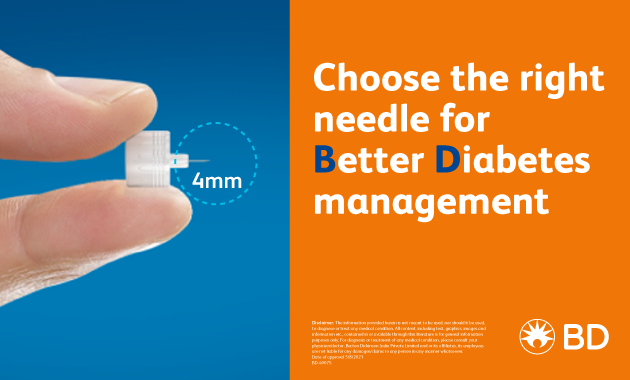
Surgical instruments are no longer sterile after a single use and same is the case with insulin pen needles and syringes. Also, if you use the same needle repeatedly, it may not be able to do its job effectively. Hence, it is recommended to use it only once and dispose of safely, thereafter.
Risks of Re-Use
1. Sterile Needle and Safety
The needle is a product of precision engineering meant to administer insulin which is a life-saving medication for people with diabetes. It is designed to do its job well, only once. There is a risk of needles not being sterile after single-use[1] and can lead to infections.
Another incorrect practice is to share needles amongst individuals. In addition to the possibility of damaging the needle, the needle reuse puts patients in danger of contracting blood borne infections like hepatitis B, hepatitis C and HIV[5].
Check Out The BD Ultra-Fine III Pen Needles 4MM 32G. Click Here To Buy.
2. Tissue Damage and Bleeding
Incorrect or multiple usage can cause damage to the needle and lead to blunting of the needle [2]. Distorted and bent needle results in more painful injection during reuse[2]. Blunt points can also cause tissue damage and bleeding. Also, reuse increases the risk of developing lumps and bumps at injection sites which can be a hurdle in the journey of good diabetes management[1,3,4].
3. Risk of Lipohypertrophy
The most common outcome of using the same needle multiple times is the formation of a lump under the skin[3,4]. Injecting into lumps and bumps can lead to erratic absorption of insulin causing hypoglycemia or fluctuations in blood sugar levels.
Watch This Video To Know About The Safe Disposal Of Needles Post Use.
Disclaimer: This is a sponsored article powered by Becton Dickinson Private Limited. The information provided in this article in the form of text, tips, suggestions, and products, which comprises general advice for consumers. 1mg does not endorse any brands and is not responsible for their efficacy.
References:
1.Richard I.G. Holt. Textbook of Diabetes, Fifth Edition, Chichester, West Sussex, UK, Wiley Blackwell, 2017.
2.Frid AH, Kreugel G, Grassi G, et al. New insulin delivery recommendations. Mayo Clin Proc. 2016;91(9):1231-1255.
3.Blanco M, Hernández MT, Strauss KW, Amaya M. Prevalence and risk factors of lipohypertrophy in insulin-injecting patients with diabetes. Diabetes Metab.
4.Richard I.G. Holt. Textbook of Diabetes, Fifth Edition, Chichester, West Sussex, UK, Wiley Blackwell, 2017. 2016;91(9):1224-1230
5.Tandon N, Kalra S, Balhara YP, Baruah MP, Chadha M, Chandalia HB, et al. Forum for injection technique and therapy expert recommendations, India: The Indian recommendations for best practice in insulin injection technique, 2017. Indian J Endocr Metab 2017;21:600-17.
Disclaimer: The information provided herein is not meant to be used, nor should it be used, to diagnose or treat any medical condition. All content, including text, graphics, images and information etc., contained in or available through this literature is for general information purposes only. For diagnosis or treatment of any medical condition, please consult your physician/doctor. Becton Dickinson India Private Limited and or its affiliates, its employees are not liable for any damages/claims to any person in any manner whatsoever.
Becton Dickinson Private Limited. 6th Floor , Signature Tower – B, South City I, NH 8, Delhi – Jaipur Expy, Saini Khera Village, Sector 30, Gurugram, Haryana 122001. © 2021 BD. All rights reserved. BD and the BD Logo are trademarks of Becton, Dickinson and Company. All other trademarks are the property of their respective owners.